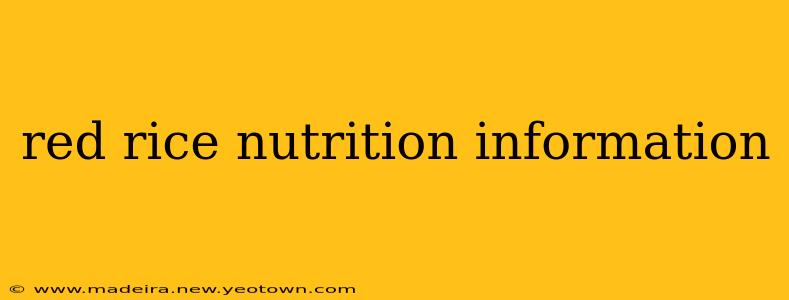Red rice, a less-processed cousin of the ubiquitous white rice, boasts a rich nutritional profile that has captivated health-conscious individuals for centuries. Unlike its refined counterpart, red rice retains its bran and germ, leading to a powerhouse of vitamins, minerals, and antioxidants. Let's embark on a journey to uncover the nutritional secrets of this ancient grain.
What are the Nutritional Benefits of Red Rice?
Red rice's nutritional superiority stems from its less-processed nature. The bran and germ, often removed during white rice processing, are packed with beneficial compounds. This translates to a higher fiber content, crucial for digestive health and promoting satiety. It also contains a wider array of vitamins and minerals, including magnesium, manganese, phosphorus, and selenium – essential nutrients for various bodily functions.
Furthermore, red rice is a good source of antioxidants, particularly anthocyanins, which give the rice its distinctive red hue. These antioxidants are associated with numerous health benefits, including reducing inflammation and protecting against cell damage. This makes red rice a valuable addition to a balanced diet focused on disease prevention.
Is Red Rice Better Than White Rice?
The answer is a resounding "yes," when comparing nutritional value. White rice, stripped of its bran and germ during processing, loses a significant portion of its fiber, vitamins, and minerals. While white rice offers carbohydrates for energy, red rice provides a more comprehensive nutritional package. This difference makes red rice a better choice for individuals seeking a more nutrient-dense carbohydrate source.
What are the Different Types of Red Rice?
Several types of red rice exist, each with its own unique characteristics. While the nutritional differences might be subtle, understanding these variations can help you choose the best variety for your needs:
- Traditional Red Rice: This is often the most readily available type and provides a good balance of nutrients.
- Black Rice (Forbidden Rice): Known for its deep purple-black color, black rice is even richer in anthocyanins than red rice.
- Red Cargo Rice: This variety is known for its nutty flavor and chewy texture.
How Many Calories are in Red Rice?
A typical serving of cooked red rice (approximately 1 cup) contains roughly 200-250 calories. However, this can vary depending on the specific type of red rice and cooking methods.
What are the Health Benefits of Eating Red Rice?
The nutritional profile of red rice translates into a range of health benefits. Let's explore some key advantages:
- Improved Digestion: The high fiber content promotes regularity and healthy bowel movements.
- Reduced Risk of Chronic Diseases: The antioxidants help combat inflammation and protect against cell damage, potentially reducing the risk of heart disease, type 2 diabetes, and certain cancers.
- Better Blood Sugar Control: The fiber helps regulate blood sugar levels, making it a suitable option for people with diabetes or those seeking to manage their blood sugar.
- Increased Energy Levels: The complex carbohydrates provide sustained energy, avoiding the blood sugar spikes and crashes associated with refined carbohydrates.
How to Incorporate Red Rice into Your Diet?
Red rice is a versatile grain that can be incorporated into various dishes. It can be used as a substitute for white rice in stir-fries, salads, soups, and bowls. It also complements flavorful sauces and spices.
Red Rice vs Brown Rice: Which is Healthier?
Both red and brown rice are whole grains, offering significant nutritional advantages over white rice. Brown rice typically contains a slightly higher fiber content compared to red rice. However, red rice shines in its abundance of anthocyanins, powerful antioxidants lacking in brown rice. Ultimately, the "healthier" choice depends on individual dietary needs and preferences. Both are excellent choices for a healthy diet.
In conclusion, red rice stands out as a nutritious and delicious whole grain that deserves a prominent place in a balanced diet. Its rich nutritional profile, including high fiber, antioxidants, and essential vitamins and minerals, contributes to improved digestive health, reduced risk of chronic diseases, and enhanced overall well-being. Give this ancient grain a try and experience the difference!

